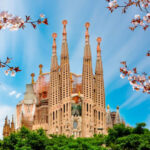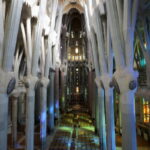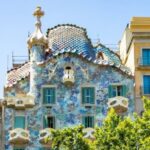
Barcelona, a city where the sea meets history, offers an enchanting journey for those eager to explore its diverse neighborhoods. The vibrant waterfront, with its bustling promenade and stunning views, serves as the perfect starting point for an adventure through the city's rich cultural tapestry.
To fully appreciate the contrasts that define Barcelona, **Head from the waterfront to the Gothic Quarter**. This historic district, with its narrow medieval streets and exquisite architecture, invites visitors to step back in time and experience the essence of the city's past, making every corner a delightful discovery.
Exploring the Scenic Route: From the Waterfront to the Gothic Quarter
As you embark on your journey from the waterfront to the Gothic Quarter, prepare to be captivated by the stunning views and vibrant atmosphere. Along the waterfront, the gentle waves of the Mediterranean create a serene backdrop, while the lively atmosphere is complemented by a variety of cafés and shops. This scenic route is not just about the sights; it’s an opportunity to immerse yourself in the local culture through street performances and art installations.
Walking towards the Gothic Quarter, you will encounter a striking contrast in architecture and ambiance. The transition from the modern beachfront to the medieval charm of the Gothic Quarter is a feast for the senses. Notable highlights include:
- The awe-inspiring Catedral de Barcelona, a masterpiece of Gothic architecture.
- The Plaça del Rei, a historical square that echoes the city's royal past.
- The enchanting narrow alleys adorned with hidden gems, including quaint shops and local eateries.
Along this scenic route, it’s easy to lose track of time as each step reveals another layer of Barcelona's rich heritage. The journey allows visitors to appreciate the blend of history and modernity, where ancient stone walls stand in harmony with contemporary art. This unique juxtaposition makes every moment spent transitioning from the waterfront to the Gothic Quarter a memorable experience.
To enhance your exploration, consider planning your route wisely. Here’s a simple comparison of key attractions:
| Attraction | Location | Highlight |
|---|---|---|
| Catedral de Barcelona | Gothic Quarter | Stunning architecture and historic significance |
| Port Vell | Waterfront | Scenic views and vibrant leisure activities |
| La Rambla | Connecting both areas | Iconic street filled with shops and performers |
Must-See Attractions Between the Waterfront and the Gothic Quarter
As you make your way from the waterfront to the Gothic Quarter, one of the must-see attractions along the route is the iconic W Barcelona Hotel. This striking sail-shaped structure not only offers breathtaking views of the Mediterranean but also houses upscale dining options and a lively beach club. Don’t miss the chance to snap a few pictures in front of this architectural marvel before continuing your journey.
Continuing along the promenade, you'll encounter La Barceloneta, a vibrant neighborhood known for its beautiful beach and seafood restaurants. Here, you can indulge in delicious tapas while soaking up the sun or take a leisurely stroll along the sandy shores. This area is perfect for experiencing the local beach culture, making it a delightful stop on your way to the Gothic Quarter.
As you approach the Gothic Quarter, make sure to visit the bustling Mercat de Sant Josep de la Boqueria, or simply La Boqueria. This famous market is a feast for the senses, offering a dazzling array of fresh produce, local delicacies, and vibrant stalls. It’s an ideal place to grab a quick bite or simply enjoy the lively atmosphere of this culinary hotspot.
Finally, don’t overlook the Palau de la Música Catalana, a UNESCO World Heritage site renowned for its stunning Modernisme architecture. Just a short detour from your path, this concert hall features an opulent interior adorned with intricate mosaics and stained glass. Attending a performance here or taking a guided tour can be a memorable highlight before you fully immerse yourself in the historical streets of the Gothic Quarter.
A Culinary Journey: Dining Options from the Waterfront to the Gothic Quarter
As you venture from the waterfront towards the Gothic Quarter, prepare to indulge in a culinary journey that reflects the vibrant culture of Barcelona. The waterfront offers a plethora of dining options, from casual beach bars to upscale restaurants, where you can savor local seafood dishes and authentic Catalan flavors. Don't miss the opportunity to try:
- Fresh paella at a seaside restaurant.
- Traditional tapas at charming beachfront bistros.
- Refreshing cocktails with a view of the Mediterranean.
Continuing your exploration, the vibrant streets leading to the Gothic Quarter reveal a diverse array of dining spots that cater to all tastes. Here, the medieval charm sets the stage for cozy eateries and trendy cafés. Some highlights include:
- Historic taverns offering classic Spanish dishes.
- Innovative fusion restaurants blending local and international cuisines.
- Charming cafés perfect for people-watching while enjoying artisanal pastries.
Don't forget to stop by the famous Mercat de Sant Josep de la Boqueria, where the lively atmosphere is matched only by the incredible variety of local produce and gourmet offerings. Here, you can sample:
- Freshly sliced jamón ibérico from local vendors.
- Exotic fruits and colorful vegetables perfect for a snack.
- Delicious prepared meals from vendors showcasing Catalan specialties.
As you transition into the Gothic Quarter, the culinary scene transforms, inviting you to discover hidden gems tucked away in narrow alleys. Each restaurant tells a story through its menu, offering a unique taste of Barcelona's rich gastronomic heritage. Embrace the flavors of this captivating city, where every meal is a celebration of its vibrant culture.
Historic Landmarks Along the Way: From the Waterfront to the Gothic Quarter
As you journey from the waterfront to the Gothic Quarter, be prepared to encounter a series of historic landmarks that showcase Barcelona's rich architectural heritage. Each site along the way tells a tale of the city's evolution, blending the old and the new. Notable landmarks include:
- Port Vell, a revitalized harbor that serves as a gateway to both leisure and history.
- The iconic Columbus Monument, which commemorates the famous explorer and offers panoramic views of the city.
- The vibrant La Rambla, a lively avenue bustling with street performers and shops connecting both regions.
Continuing along the route, the Palau Güell stands as a testament to the genius of Antoni Gaudí. This mansion, designed for the industrial tycoon Eusebi Güell, features stunning interiors and an impressive rooftop adorned with colorful chimneys. Visiting this landmark offers a glimpse into the innovative spirit of modernist architecture that defines much of Barcelona.
As you approach the Gothic Quarter, the Plaça de Catalunya serves as a major junction where history meets modernity. This expansive square is not only a popular meeting point but also home to impressive sculptures and fountains. From here, the enchanting streets of the Gothic Quarter unfold, inviting exploration of its hidden corners and historic treasures.
Ultimately, the transition from the waterfront to the Gothic Quarter is a journey through time. Each landmark reflects the city’s diverse narrative, from ancient Roman relics to the vibrant life of contemporary Barcelona. This rich tapestry of history makes your exploration not just a walk but an immersive experience in cultural heritage.
Cultural Highlights: Discovering Art and History from the Waterfront to the Gothic Quarter
As you make your way from the waterfront to the Gothic Quarter, immerse yourself in the diverse array of cultural highlights that define Barcelona. This journey is not merely a stroll; it's an exploration of art and history where each step reveals the city's vibrant soul. Along the waterfront, you'll find stunning contemporary art installations that celebrate the city's maritime heritage, enhancing the scenic beauty of the coastline. The transition into the narrow streets of the Gothic Quarter unveils a world of medieval architecture, offering a stark yet beautiful contrast to the modernity of the waterfront.
One of the key cultural highlights is the Museu d'Historia de Barcelona (MUHBA), located in the Gothic Quarter. This museum invites visitors to delve into the city's past, showcasing Roman ruins and artifacts that date back to ancient times. As you navigate through the maze-like streets, you'll also encounter historic squares like Plaça del Pi and Plaça de Sant Felip Neri, each adorned with breathtaking architecture and rich stories waiting to be discovered. These spots epitomize the blend of history and culture, making your visit truly enriching.
Alongside the historical landmarks, the artistic vibe of the area is prominent. The Gothic Quarter is home to numerous art galleries and workshops where local artists display their creations. This artistic presence fosters a sense of community and creativity, offering visitors a chance to engage with the local culture. Don’t forget to stop by the vibrant street markets scattered throughout the quarter, where you can find unique crafts and art pieces that reflect Barcelona's eclectic spirit.
In summary, the journey from the waterfront to the Gothic Quarter is an unforgettable cultural experience that celebrates both the past and present of Barcelona. The contrast between the lively waterfront and the historic ambiance of the Gothic Quarter is a testament to the city’s dynamic character. Whether you're captivated by the stunning architecture or the rich artistic expressions, this route promises to leave a lasting impression on every traveler.
A Traveler's Guide: Navigating from the Waterfront to the Gothic Quarter
As you navigate from the waterfront to the Gothic Quarter, it's essential to take in the various landmarks that highlight Barcelona's rich history. The journey encompasses a blend of modern attractions and historical sites, making it a unique experience for travelers. Don't miss iconic spots such as:
- Port Vell, which offers both leisure and a glimpse into the city’s maritime past.
- The Columbus Monument, providing panoramic views and a nod to exploration.
- The vibrant vibe of La Rambla, connecting the two regions with energy and life.
As you stroll through the streets, be sure to appreciate the cultural richness that defines this route. The waterfront features contemporary art and bustling cafés, while the Gothic Quarter surprises with its medieval architecture and charming plazas. Key points of interest include:
- The Catedral de Barcelona, a striking example of Gothic architecture.
- The Mercat de Sant Josep de la Boqueria, a culinary hotspot filled with local flavors.
- The Palau de la Música Catalana, showcasing exquisite Modernisme design.
Moreover, this journey is a feast for the senses, where each step immerses you deeper into Barcelona's vibrant culture. As you transition from the modern beachfront to the historical ambiance of the Gothic Quarter, be prepared to encounter lively street performers and local artisans showcasing their work. This dynamic blend of tradition and innovation makes every moment memorable.
In conclusion, crossing from the waterfront to the Gothic Quarter is not just about the sights; it’s about embracing the myriad experiences that Barcelona offers. From delicious culinary delights to significant architectural wonders, this route invites travelers to explore and appreciate the essence of this captivating city.
 Discovering the Location of Sagrada Familia in Barcelona: A Must-Visit Landmark
Discovering the Location of Sagrada Familia in Barcelona: A Must-Visit Landmark Sagrada Familia Finish Date: When Will It Be Completed?
Sagrada Familia Finish Date: When Will It Be Completed? Admission Required: Casa Batlló is not free
Admission Required: Casa Batlló is not freeIf you want to know other articles similar to Head from the waterfront to the Gothic Quarter. you can visit the category WHERE YOU CAN GO.
Leave a Reply










Read more!